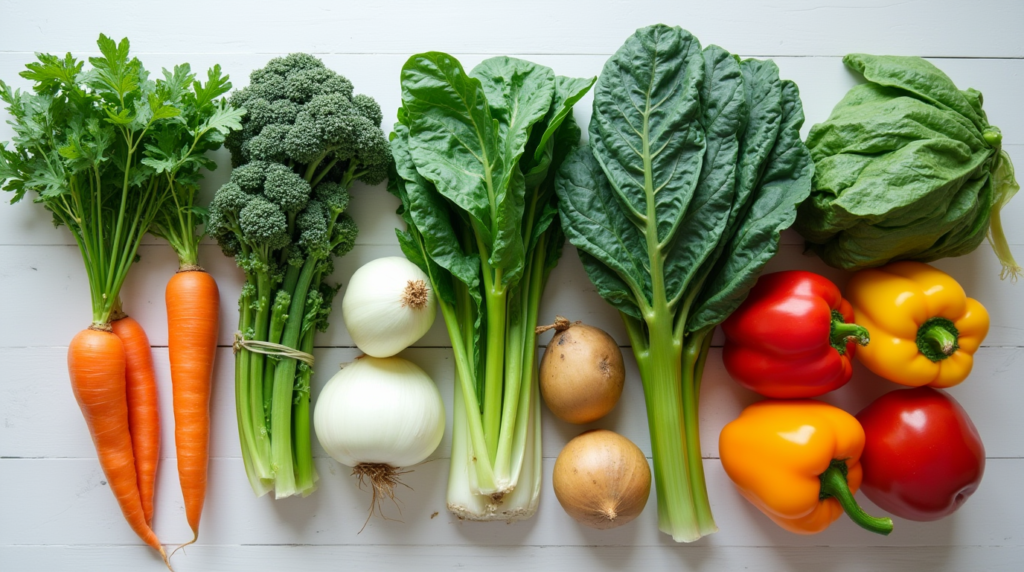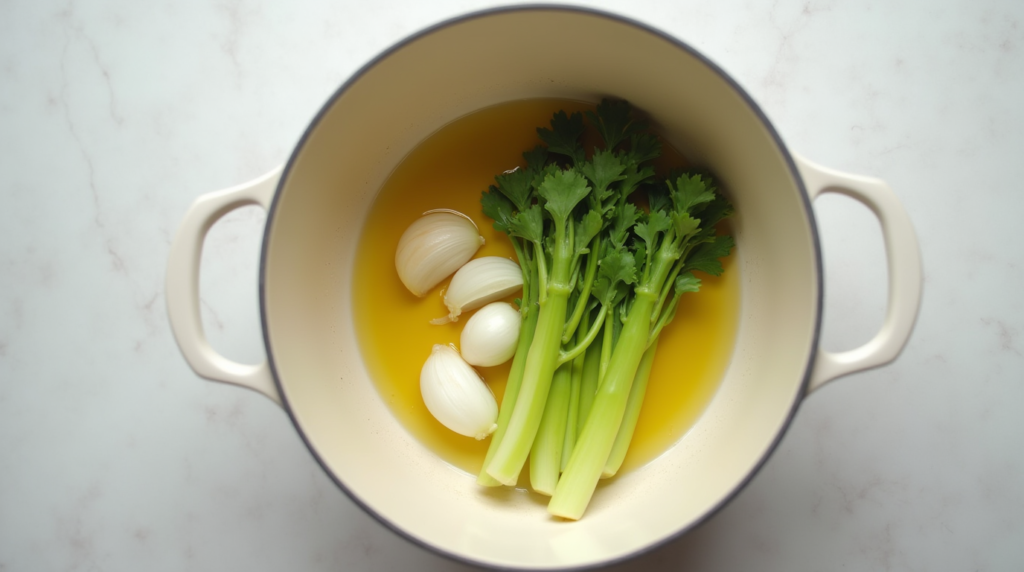10 Vegetable Soup Recipe – Nutritious, Hearty & Easy to Make
Are you looking for a nutritious and filling meal that’s easy to prepare? Look no further than a hearty vegetable soup made with a variety of fresh ingredients. This 10 vegetable soup recipe is packed with vitamins, minerals, and antioxidants, making it a great way to boost your health.
Not only is this healthy vegetable soup recipe good for you, but it’s also incredibly easy to make. With a prep time of just a few minutes, you can have a delicious and easy vegetable soup ready to enjoy in no time.
Key Takeaways
- A nutritious and hearty soup option for a quick meal.
- Packed with vitamins, minerals, and antioxidants.
- Easy to prepare with minimal prep time.
- Customizable with your favorite vegetables.
- A great way to boost your health and satisfy your appetite.
The Health Benefits of Vegetable Soup
A bowl of homemade vegetable soup can be a powerhouse of nutrition, supporting various bodily functions. This nutritious meal is not just comforting but also packed with vitamins, minerals, and antioxidants.
Nutritional Powerhouse in a Bowl
Vegetable soup is a nutrient-rich food that combines a variety of vegetables, each contributing its unique nutritional profile. For instance, carrots are high in vitamin A, while spinach is rich in iron. This diversity ensures that your body receives a broad spectrum of nutrients.
- Rich in vitamins and minerals
- High in antioxidants
- Supports healthy digestion
How Vegetable Soup Supports Your Immune System
Consuming a healthy vegetable soup recipe can significantly support your immune system. The ingredients in vegetable soup, such as garlic and onions, have immune-boosting properties. Moreover, the steam from hot soup can help ease congestion, making it easier to breathe.
Key ingredients that support immune function include:
- Garlic
- Onions
- Ginger
By incorporating vegetable soup into your diet, you’re not just enjoying a meal; you’re also taking a proactive step towards enhancing your overall health and wellbeing.
The Perfect 10 Vegetable Soup Recipe: Overview
In the world of soups, our 10 vegetable recipe stands out for its simplicity and nutritional value. This section provides an overview of what makes this recipe special and how it fits into your lifestyle in terms of time and budget.
What Makes This Recipe Special
Our 10 vegetable soup recipe is more than just a meal; it’s a nutritious powerhouse packed with a variety of vegetables, making it a perfect option for those seeking a healthy diet. The diversity of vegetables ensures a broad spectrum of vitamins and minerals, enhancing the soup’s nutritional profile.
The recipe is also highly customizable, allowing you to adjust the vegetables based on seasonality and personal preference, making it a versatile option for any time of the year.
Time and Budget Considerations
One of the key benefits of this recipe is its time efficiency. It requires minimal preparation time and can be cooked in under an hour, making it suitable for busy lifestyles.
From a budget perspective, using seasonal vegetables can significantly reduce costs. The table below illustrates the average cost of the key ingredients and how they vary by season.
| Vegetable | In-Season Price | Out-of-Season Price |
|---|---|---|
| Carrots | $1.50/lb | $2.50/lb |
| Potatoes | $1.00/lb | $2.00/lb |
| Onions | $0.80/lb | $1.80/lb |
10 Star Vegetables for Your Soup
To create a truly exceptional vegetable soup, you need to start with a diverse selection of vegetables. The beauty of a homemade vegetable soup lies in its versatility and the ability to customize it according to your taste preferences and dietary needs.
The vegetables you choose will not only determine the flavor profile but also the nutritional value of your healthy vegetable soup recipe. Let’s explore the star vegetables that make your soup both nourishing and delicious.

Root Vegetables: Carrots, Potatoes, and Turnips
Root vegetables are the backbone of a hearty homemade vegetable soup. Carrots add a sweet and crunchy texture, while potatoes contribute to the soup’s thickness and heartiness. Turnips, with their slightly peppery flavor, add depth to the broth. Together, these root vegetables create a robust flavor profile that is both satisfying and comforting.
- Carrots: Rich in vitamin A, they support healthy vision and immune function.
- Potatoes: High in fiber and potassium, they contribute to heart health.
- Turnips: Low in calories, they are a good source of vitamins and minerals.
Leafy Additions: Kale and Spinach
Leafy greens like kale and spinach are nutritional powerhouses that elevate your vegetable soup to new heights. They are packed with vitamins A, C, and K, as well as minerals like calcium and iron. Adding these leafy greens towards the end of cooking preserves their nutrients and adds a burst of color to your soup.
- Kale: Rich in antioxidants, it supports overall health and well-being.
- Spinach: High in iron, it is beneficial for healthy red blood cells.
Aromatics and Others: Onions, Garlic, Celery, Bell Peppers, and Tomatoes
Aromatics and other vegetables like onions, garlic, celery, bell peppers, and tomatoes form the flavor foundation of your healthy vegetable soup recipe. They sautéed together create a rich, savory broth that is both aromatic and flavorful. These vegetables are not only delicious but also packed with vitamins, minerals, and antioxidants.
- Onions and Garlic: Known for their immune-boosting properties.
- Celery: Adds freshness and supports digestive health.
- Bell Peppers: Rich in vitamin C, they enhance the soup’s nutritional profile.
- Tomatoes: Contribute to the soup’s acidity and are a good source of lycopene.
Essential Base Ingredients and Broth Options
The secret to a mouth-watering vegetable soup is in the base ingredients and the broth you choose. A well-crafted broth serves as the backbone of your soup, providing depth and richness that elevates the overall flavor.
Choosing the Right Broth
When it comes to making an easy vegetable soup, selecting the right broth is crucial. You can opt for a store-bought broth or make your own. Homemade broth, while more time-consuming, allows you to control the ingredients and the flavor profile. Vegetable broth can be made with a variety of vegetables, such as carrots, celery, and onions, and can be enhanced with spices for vegetable soup like bay leaves and peppercorns. If you’re short on time, look for a low-sodium store-bought option to keep your soup healthy.
Additional Base Ingredients for Depth
Beyond the broth, additional base ingredients can add complexity and depth to your vegetable soup. Ingredients like garlic, ginger, and onions sautéed in olive oil create a flavorful foundation. Tomatoes or tomato paste can add a rich, tangy flavor, while a splash of acidity from lemon juice or vinegar can brighten the overall taste. Experimenting with different combinations of these ingredients will help you find the perfect balance for your soup.
Kitchen Equipment for Homemade Vegetable Soup
Preparing a hearty vegetable soup requires some essential kitchen tools. With the right equipment, you can make your homemade vegetable soup preparation process smoother and more efficient.
Must-Have Tools
To start, you’ll need a few must-have tools. A large pot, preferably a Dutch oven, is crucial for cooking your soup. A cutting board and a sharp knife are necessary for chopping the vegetables. Additionally, a measuring cup and spoons will help you achieve the right balance of flavors in your easy vegetable soup.
Optional Equipment That Makes Cooking Easier
While not necessary, some equipment can make the cooking process easier. An immersion blender allows you to puree the soup directly in the pot, saving you the step of transferring it to a blender. A slow cooker is another useful tool, enabling you to cook your 10 vegetable soup recipe over a long period, developing rich flavors.
Preparation Steps: Getting Your Vegetables Ready
To make the best vegetable soup, you need to get your vegetables ready with the right techniques. Proper preparation is crucial for bringing out the flavors and textures of the vegetables, ultimately enhancing your homemade vegetable soup.
Proper Washing and Cutting Techniques
Washing your vegetables is the first step in preparing them for your soup. It’s essential to remove any dirt, pesticide residue, or other contaminants. Use cold running water to wash the vegetables, and for leafy greens like kale and spinach, consider using a salad spinner to remove excess water. After washing, cutting the vegetables into uniform pieces ensures they cook evenly. For root vegetables like carrots and potatoes, peeling and dicing them into similar-sized chunks is ideal. For leafy greens, chopping them into manageable pieces helps release their flavors during cooking.
Time-Saving Preparation Hacks
To save time on preparation, consider a few hacks. First, you can chop your vegetables in advance and store them in airtight containers in the refrigerator. Another time-saving tip is to use pre-cut or frozen vegetables. Many grocery stores now offer pre-washed and pre-cut vegetables, which can significantly reduce your prep time. Additionally, using a food processor to chop or slice your vegetables can be a huge time-saver, especially for larger quantities.
Step-by-Step 10 Vegetable Soup Recipe Instructions
Making a hearty 10 vegetable soup is easier than you think, and it all starts with building a solid flavor foundation. To create a rich and satisfying soup, you’ll need to follow a few straightforward steps.
Building the Flavor Foundation
The first step in making your 10 vegetable soup is to create a flavorful base. This involves sautéing aromatic vegetables like onions, garlic, and celery in a bit of oil until they’re softened and fragrant. This process enhances the overall flavor of your soup, providing a depth that will make it truly satisfying.

Adding Vegetables in the Correct Sequence
Once your flavor foundation is ready, it’s time to add the vegetables. Start with the root vegetables like carrots and potatoes, as they take longer to cook. Next, add leafy greens such as kale and spinach towards the end of the cooking time, so they retain their nutrients and color. This sequence ensures that all the vegetables are cooked to perfection.
| Vegetable Type | Cooking Time | Addition Sequence |
|---|---|---|
| Root Vegetables | 20-25 minutes | First |
| Leafy Greens | 5-7 minutes | Last |
| Aromatics | 5 minutes | First |
Simmering Times and Temperature Control
After adding all the vegetables, bring your soup to a boil and then reduce the heat to a simmer. Let it cook for about 30-40 minutes, or until the vegetables are tender. Maintaining a gentle simmer is crucial, as it allows the flavors to meld together and the vegetables to cook evenly.
Best Spices and Herbs for Vegetable Soup
The right spices and herbs can transform your vegetable soup into a culinary delight. By incorporating the perfect blend, you can enhance the flavor and nutritional value of your healthy vegetable soup recipe.
Different cultures offer unique seasoning combinations that can elevate your vegetable soup. Let’s explore a few popular options to inspire your cooking.
Classic American Seasoning Combinations
In American cuisine, traditional seasoning combinations often feature thyme, bay leaves, and black pepper. These herbs complement the natural flavors of the vegetables without overpowering them. You can also add a hint of paprika for a smoky depth or rosemary for a piney note.
Mediterranean Flavor Profile
The Mediterranean region is known for its bold flavors, often incorporating oregano, basil, and garlic into soups. These ingredients add a rich, savory taste to your vegetable soup. Consider adding a squeeze of fresh lemon juice to brighten the flavors.
Asian-Inspired Seasoning Options
For an Asian-inspired flavor, you can use ginger, star anise, and soy sauce to create a savory and aromatic spices for vegetable soup blend. These ingredients will give your soup a distinct and exotic taste, perfect for those looking to explore new flavors.
| Region | Key Spices/Herbs | Flavor Profile |
|---|---|---|
| Classic American | Thyme, Bay Leaves, Black Pepper | Traditional, earthy |
| Mediterranean | Oregano, Basil, Garlic | Bold, savory |
| Asian-Inspired | Ginger, Star Anise, Soy Sauce | Savory, aromatic |
Making Your Soup Heartier: Protein and Grain Additions
For a more substantial vegetable soup, explore various protein and grain add-ins. Adding the right ingredients can transform your soup from a light meal into a satisfying and filling one. This section will guide you through the best options to enhance your homemade vegetable soup.
Bean and Legume Options
Beans and legumes are excellent sources of protein and fiber, making them perfect for adding heft to your vegetable soup. Popular choices include kidney beans, black beans, chickpeas, and lentils. These not only add protein but also complement the existing vegetables with their unique flavors and textures.
- Kidney beans for a classic addition
- Black beans for a Latin-inspired flavor
- Chickpeas for a Mediterranean twist
- Lentils for a boost in fiber and protein
Whole Grains That Complement Vegetables
Incorporating whole grains can add depth and satisfaction to your soup. Options like quinoa, barley, and brown rice are not only nutritious but also pair well with a variety of vegetables. Quinoa, for instance, is a complete protein, making it an excellent choice for vegetarians.
| Whole Grain | Nutritional Benefit | Pairing Suggestion |
|---|---|---|
| Quinoa | Complete protein, high in fiber | Roasted vegetables |
| Barley | Rich in fiber, vitamins, and minerals | Mushrooms and root vegetables |
| Brown Rice | Good source of manganese and selenium | Leafy greens and carrots |
Animal Protein Add-ins (For Non-Vegetarian Versions)
For those who consume meat, adding animal proteins can make the soup even heartier. Options include diced chicken, beef, or sausage for added flavor. You can also use leftover roasted meats to simplify preparation.
Tips for adding animal protein: Use pre-cooked meats to save time, or simmer raw meat directly in the soup for enhanced flavor.
Dietary Adaptations of Your Vegetable Soup
Your vegetable soup can be tailored to meet specific dietary needs with a few adjustments. Whether you’re catering to gluten-free, low-sodium, vegan, or vegetarian requirements, modifying your recipe is straightforward. This flexibility makes your healthy vegetable soup recipe accessible to everyone.
Gluten-Free Modifications
For a gluten-free version, focus on the broth and any additional ingredients like grains or thickeners. Use gluten-free broth and be cautious with ingredients that may contain gluten. Some vegetable soups may include barley or wheat-based thickeners, so opt for gluten-free alternatives like rice, quinoa, or corn.
Low-Sodium Versions
Reducing sodium in your vegetable soup is achievable by using low-sodium broth or making your broth from scratch with fresh vegetables and herbs. Limit or avoid adding salt, and enhance flavors with spices for vegetable soup like cumin, paprika, or herbs such as thyme and rosemary.
Vegan and Vegetarian Options
For vegan and vegetarian diets, ensure that your broth is plant-based. Vegans should avoid any animal-derived products, including honey and certain types of refined sugar. Vegetarians can include dairy or eggs if they choose. Both diets benefit from a variety of vegetables and can be enriched with beans, lentils, or tofu for added protein.
| Dietary Need | Modifications |
|---|---|
| Gluten-Free | Use gluten-free broth, avoid gluten-containing grains |
| Low-Sodium | Use low-sodium broth, limit added salt, enhance with spices |
| Vegan/Vegetarian | Use plant-based broth, avoid animal products (vegan), consider dairy or eggs (vegetarian) |
By making these simple adjustments, you can enjoy a delicious and healthy vegetable soup that meets your dietary needs.
Serving Suggestions and Creative Pairings
Enhance your homemade vegetable soup experience with creative serving ideas and pairings. The right accompaniments can turn a simple bowl of soup into a satisfying meal. Here are some suggestions to get you started.
Bread and Cracker Accompaniments
Pairing your vegetable soup with the right bread or crackers can add texture and flavor. Consider serving with:
- Crusty whole-grain bread for a hearty combination
- Croutons made from baguette slices for added crunch
- Whole-grain crackers for a lighter option
- Focaccia or ciabatta for a more rustic feel
Salads That Complement Your Soup
A fresh salad can provide a refreshing contrast to the warm, comforting soup. Try pairing with:
| Salad Type | Description |
|---|---|
| Green Salad | A simple mix of greens, cherry tomatoes, and a light vinaigrette |
| Roasted Beet Salad | Roasted beets, mixed greens, and a tangy goat cheese dressing |
| Quinoa Salad | Cooked quinoa mixed with chopped vegetables and a citrus dressing |
Garnishes That Elevate Presentation and Flavor
Garnishes can add a pop of color and extra flavor to your soup. Consider:
- Fresh herbs like parsley or cilantro for a fresh taste
- A dollop of sour cream or Greek yogurt for creaminess
- Croutons or toasted bread crumbs for added texture
- A sprinkle of grated cheese, such as parmesan or cheddar, for a rich flavor

By incorporating these serving suggestions and creative pairings, you can elevate your homemade vegetable soup into a memorable dining experience. Whether you’re looking for a comforting meal or a light, healthy option, the right accompaniments can make all the difference.
Conclusion: Enjoying the Benefits of Your Homemade Vegetable Soup
Now that you’ve prepared your delicious and nutritious 10 vegetable soup recipe, it’s time to enjoy the fruits of your labor. This healthy vegetable soup recipe is not only a treat for your taste buds but also provides numerous health benefits. By incorporating a variety of vegetables, you can boost your immune system and enjoy a hearty, homemade vegetable soup that’s perfect for any meal.
As you’ve learned, making a homemade vegetable soup is a straightforward process that requires minimal equipment and can be adapted to suit various dietary needs. By following the steps outlined in this article, you can create a delicious and healthy meal that’s sure to become a staple in your kitchen.
So, go ahead and savor the flavors of your homemade vegetable soup, knowing that you’re nourishing your body with a nutritious and wholesome meal. Whether you’re looking for a comforting bowl of goodness on a chilly day or a healthy meal option, this 10 vegetable soup recipe is sure to hit the spot.
FAQ
What are the best spices to use in homemade vegetable soup?
You can use a variety of spices to season your homemade vegetable soup, including classic American seasoning combinations, Mediterranean flavor profiles, and Asian-inspired seasoning options. Some popular choices include thyme, rosemary, oregano, basil, and bay leaves.
How can I make my vegetable soup more hearty?
You can make your vegetable soup more hearty by adding protein sources like beans, legumes, or animal proteins, as well as whole grains like quinoa, barley, or brown rice. These additions will not only enhance the flavor but also increase the nutritional value of your soup.
Can I make a healthy vegetable soup recipe without compromising on flavor?
Yes, you can make a healthy vegetable soup recipe that is also flavorful. By using a variety of vegetables, herbs, and spices, you can create a delicious and nutritious soup that is low in sodium and rich in essential vitamins and minerals.
What are some easy ways to prepare vegetables for soup?
To prepare vegetables for soup, you can follow proper washing and cutting techniques. You can also use time-saving preparation hacks like chopping vegetables in advance or using pre-chopped vegetables from your grocery store.
How can I adapt my vegetable soup to suit different dietary needs?
You can adapt your vegetable soup to suit different dietary needs by making modifications such as using gluten-free ingredients, reducing sodium content, or opting for vegan or vegetarian protein sources. This will make your soup more inclusive and enjoyable for everyone.
What are some creative ways to serve vegetable soup?
You can serve vegetable soup with a variety of accompaniments like bread, crackers, or salads. You can also elevate the presentation and flavor of your soup by adding garnishes like fresh herbs, croutons, or a dollop of sour cream.
Can I make easy vegetable soup using common kitchen equipment?
Yes, you can make easy vegetable soup using common kitchen equipment like a large pot, cutting board, and knife. Optional equipment like a slow cooker or immersion blender can also make the cooking process simpler and more efficient.
Leave a Review & Rate This Recipe!
There are no reviews yet. Be the first one to write one.

